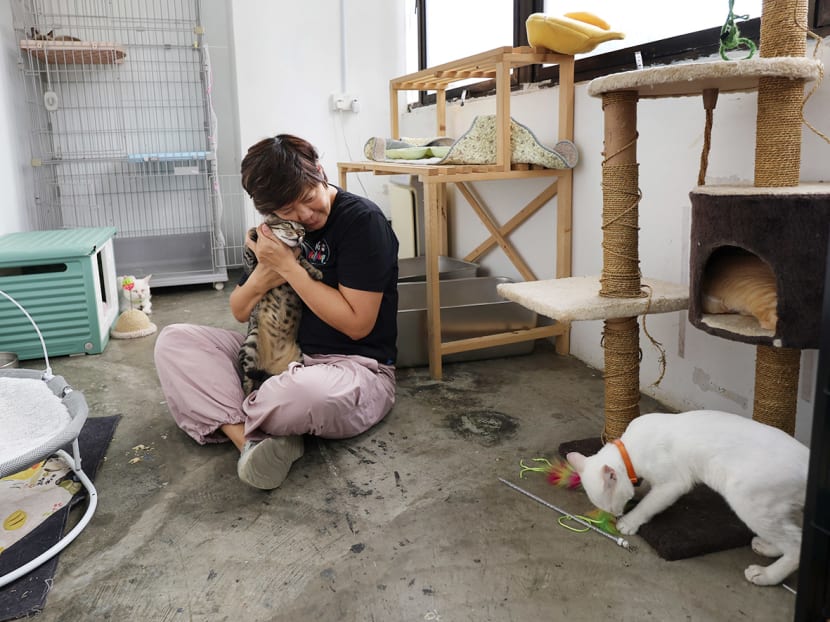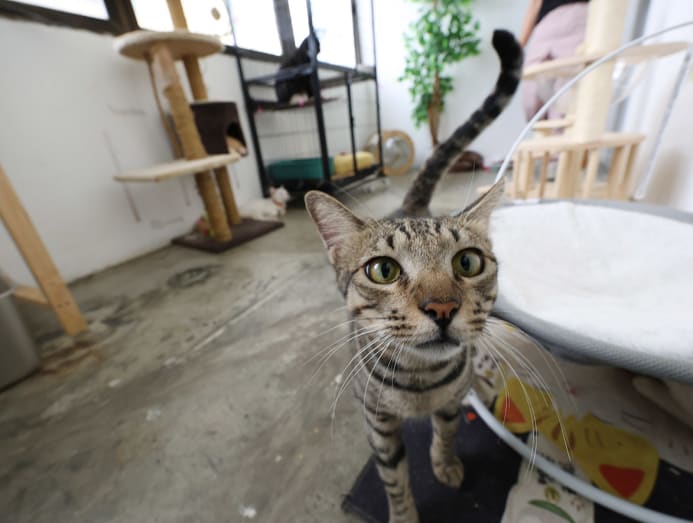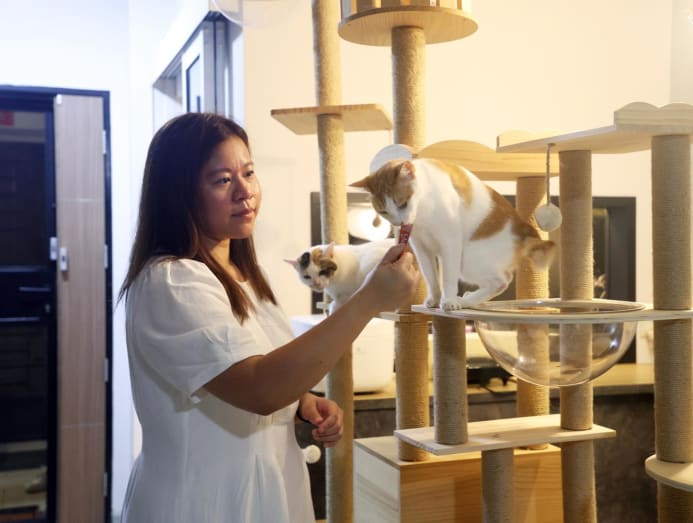Already burnt out, some cat rescuers mull quitting after spike in abandonment cases, uncertainty over new regulations

Cat fosterer Amy Sim (pictured) started a cat shelter and cat population control initiative called TNR Project Singapore eight years ago. She is also the owner of social enterprise SGPetShop.
SINGAPORE — A few nights each week, Ms Amy Sim steps out of her house for a few hours to trap stray cats, get them neutered and foster some of them before seeking new homes for them.
“There have been times when my husband wakes up in the middle of the night and finds that I’m not at home, because I'm outside to help another volunteer trap cats,” the owner of social enterprise SG Petshop said.
The pet supplies shop funds part of the operational costs of her cat shelter and cat population control initiative called TNR Project Singapore, which she started eight years ago.
TNR refers to “trap-neuter-release” — a common practice to keep the community cat population under control.
Most of the strays are placed back where they were found.
However, Ms Sim, who is in her 50s, fosters and finds permanent homes for those found in dangerous places or those with higher chances of getting adopted, such as kittens.
“But not all cats get successfully rehomed. We have one who has been with us for about six years.”
She is among many cat fosterers here who play a crucial role in getting stray and abandoned cats either off the streets or at least neutered, so that they cannot breed further.
Their already thankless work was recently made more challenging by a spike in abandonment cases after the initial announcement last December of a cat management framework, which some fosterers think may have “confused” pet owners.
The framework reverses a 34-year ban on keeping cats in public flats, and it imposes a limit of two cats in each home for new owners.
What some members of the public were less aware of, these cat volunteers said, was that the framework also allows people to keep their existing cats, regardless of the numbers.
They can do this if they have the animals licensed within the two-year transitional period.
Some volunteers are also concerned that the framework, to kick in this September, does not spell out clearly the licensing regime for fosterers.
Already burned out and operating under many constraints, some of these fosterers said that they are ready to quit fostering altogether should the rules turn out to be too burdensome.

THE TASKS FACING FOSTERERS
In order to give the felines the best shot of finding a "forever home", fosterers pour their time, money and emotions on them, no different than they would for their own pets.
1. Daily attention
The moment a fosterer takes up a case, they must clean and set aside a space in their house where they can isolate the cat.
They typically groom the cat themselves — which could take hours — and make trips to the veterinarian for the animal's check-ups, vaccinations and any necessary treatments.
Daily tasks include feeding, cleaning, monitoring the cat’s appetite and stool quality for signs of ill health as well as overseeing gradual socialisation with humans or other cats.
While juggling all this, fosterers also put up social media posts to attract potential adopters.
A 33-year-old ad-hoc fosterer for about three years who wanted to be known only as Ms Ella described the challenge.
"Fostering involves a dedicated commitment to the well-being and eventual placement of each cat, requiring both physical effort and careful planning to ensure their successful transition to a permanent home,” she said.
While it is hard to quantify, some fosterers estimated that caring for such cats collectively could take up a few hours of their time a day.
2. Commitment for months… or years
A risk that fosterers face is that it can be hard to know how long they have to keep the cats they take in. It can take months or even longer before a new home can be found.
Ms Kartika Angkawijaya, 42, who began rescuing and rehoming cats in 2018, said that some foster cases take longer than others due to the cats’ health or behavioural issues.
“At some point, I almost gave up, thinking if I would need to adopt them instead,” the product manager added.
Attracting potential adopters is only one part of the equation.
Screening them to find a committed and responsible future owner for the cat also involves more time and effort.
This can include conducting interviews, inviting the prospective adopter to view the cats in person, or visiting their home — and sometimes putting up with unkind behaviour.
“There was a potential adopter who dissed us by saying that if it’s so difficult to adopt, because of the need to cat-proof the house, and that the adopter might as well just buy the cat from a breeder,” Ms Kartika added.
3. Self-funded commitment
It is common for fosterers to charge adopters a nominal fee covering basic veterinary expenses — such as sterilisation and vaccination — but they tend to bear the bulk of the fostering costs.
Ms Sabrina who did not want to give her full name, 31, said: “For a simple and relatively healthy case, we are looking at anywhere from S$240 to S$650 (in initial cost).”
She has been involved in the sterilisation and rehoming of cats since her varsity days.
Monthly costs for basic necessities such as food and litter vary greatly but typically start at around S$100 for a cat.
Mr Alessandro Lange, 26, who does cat trapping and neutering in industrial areas as well as fostering of cats, estimated that, on average, he spends "around S$1,000 a month" on basic necessities.
This excludes the basic medical fees that adopters eventually reimburse.
The student, who funds his operations by doing freelance work, added: "Sometimes I meet adopters who are very passionate and understanding and give a little more."
Veterinary bills for cats that need serious medical attention can be as high as five-figure sums. In those cases, fosterers would turn to the public for donations.
This is made worse these days because vets also have had to raise their fees by up to 20 per cent in the last two years, owing to climbing operational costs, CNA news channel reported in January.
Fosterers also spoke about forgoing holidays or other treats for themselves and their families to set aside money to care for the cats.
Regular fosterer Michelle Shoo, 34, who does part-time work to supplement her income, said: "I’ve seen a few small cat rescue groups on Facebook that are having a deficit in funds and in debt.
"There’s even one who took up a loan to fund the rescues."

THE EMOTIONAL TOLL
Like other fosterers, Mr Lange still feels pangs of sadness at having to give away the feline friends that he has cared for and bonded with for months, despite having been doing such work since 2020.
“But then I began to think if I keep them all, I won't have the capacity to save more,” he said.
"So when I look at them going to a good family, and I think of the greater good for that cat and future cats I want to save, I feel less sad."
For every cat they manage to save from the streets and rehome, though, there would always be many others that they encounter but are unable to help.
Ms Ella, the 33-year-old ad-hoc fosterer, said: “Despite wanting to help in many cases, personal limitations often prevent me from doing so. The messages I receive requesting assistance weigh heavily on me.”
It is also not uncommon for these cat volunteers to have to deal with the death of cats that they try to help.
Ms Lynn Jefrey, 45, has rehomed more than 50 cats in the last 10 years but mainly focuses on taking in older community cats.
The part-time make up artist and cat-sitter has cared for more than 10 old and sick abandoned cats until the end of their lives in the last three or four years, on top of the dozens of community cat deaths that she has encountered on her feeding rounds.
Many such cats, which died due to accidents or being mauled by stray dogs, had been abandoned. Such unfortunate endings could have been avoided if only the cats’ former owners had not thrown their pets out, she added.
“Sometimes my husband and I feel like giving up, but we tell ourselves there are still cats out there that need our help.”
Ms Sim of TNR Project Singapore told TODAY that her team just lost a kitten last week, and she was asked by a volunteer how she copes with such cases.
“And I said, 'No choice, just cry and move on'. We have so many other cats waiting to be saved.”
AN INCREASE IN ABANDONED PET CATS
The number of abandonment and surrender cases are generally high all year round, but many fosterers and rescuers said that they saw a spike early in the year, further adding to their burden.
“(The increase) was almost as bad as during some festive seasons,” Mr Lange said.
Festive seasons are known to be peak periods for pet abandonment cases.
Ms Sabina said: “I saw an increase of abandonment and (online posts about) the ‘heavy-hearted’ rehoming of house cats on Facebook, as I moderate one of the communities online.”
She has been helping to foster and rehome three times more cats so far this year than she did the whole of last year.
“And that’s not even counting the ones I've had to turn away.”
For Ms Shoo, she has fostered about 20 cats a year since 2020.
However, since the new framework was announced last December to now, she has already fostered 26.
Each additional cat takes a toll on these fosterers’ time and resources, but it was the cats that they had to turn down that affected them even more.
“Since we are not able to take in all the abandoned cats, we have to sterilise and release the cats back on the streets,” Ms Shoo added.
“It is really sad for the cats as they have to adapt to street life when they were once well-loved home cats.”

Ms Thenuga Vijakumar, president of the Cat Welfare Society, said that the organisation also received feedback on such an increase earlier this year.
“This seems to have plateaued with misinformation being corrected,” she added, without giving an exact timeline.
The cat volunteers stressed to TODAY — as many others did late last year — that the long-term solution to cat abandonment issues hinges on mandatory sterilisation.
FOSTERERS CONSIDER CALLING QUITS
The confusion around licensing for regular cat owners has largely cleared up, but the regulations for fosterers are still in the works, though they can already begin registering the foster cats with the authorities come Sept 1 next year.
Ms Thenuga of the Cat Welfare Society said: “Our concern is that some fosterers may feel that the regulations restrict their fostering abilities or capacities especially if there are fetters on numbers.”
The cat volunteers agreed that having some regulation has its benefits, such as ensuring that fosterers do not take on too many cats at the expense of the animals’ welfare.
Ms Sabrina, however, noted that if the authorities intend to “vet every single fosterer”, the process may take too long and there would not be enough fosterers to help with the abandoned cases out there.
“Or potential fosterers will drop out of the pool due to the wait and the bureaucracy,” she said.
Many fosterers are already mulling the option of quitting to avoid potential “legal liabilities” arising from future regulations, she added.
The Cat Welfare Society emphasised the need for the authorities and welfare groups to work together to ensure that the future regulations do not hinder the fosterers’ work.
At the same time, people should be able to foster cats "in a manner that does not overly tax them or their resources" and they can uphold standards such as "not causing disamenities to neighbours”.
“We must concurrently grow the pool of fosters and resources available for cats so that the current group’s burdens are alleviated,” Ms Thenuga said.








